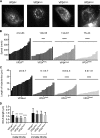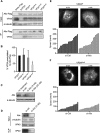The Integrity of the YxxL Motif of Ebola Virus VP24 Is Important for the Transport of Nucleocapsid-Like Structures and for the Regulation of Viral RNA Synthesis
- PMID: 32102881
- PMCID: PMC7163145
- DOI: 10.1128/JVI.02170-19
The Integrity of the YxxL Motif of Ebola Virus VP24 Is Important for the Transport of Nucleocapsid-Like Structures and for the Regulation of Viral RNA Synthesis
Abstract
While it is well appreciated that late domains in the viral matrix proteins are crucial to mediate efficient virus budding, little is known about roles of late domains in the viral nucleocapsid proteins. Here, we characterized the functional relevance of a YxxL motif with potential late-domain function in the Ebola virus nucleocapsid protein VP24. Mutations in the YxxL motif had two opposing effects on the functions of VP24. On the one hand, the mutation affected the regulatory function of VP24 in viral RNA transcription and replication, which correlated with an increased incorporation of minigenomes into released transcription- and replication-competent virus-like particles (trVLPs). Consequently, cells infected with those trVLPs showed higher levels of viral transcription. On the other hand, mutations of the YxxL motif greatly impaired the intracellular transport of nucleocapsid-like structures (NCLSs) composed of the viral proteins NP, VP35, and VP24 and the length of released trVLPs. Attempts to rescue recombinant Ebola virus expressing YxxL-deficient VP24 failed, underlining the importance of this motif for the viral life cycle.IMPORTANCE Ebola virus (EBOV) causes a severe fever with high case fatality rates and, so far, no available specific therapy. Understanding the interplay between viral and host proteins is important to identify new therapeutic approaches. VP24 is one of the essential nucleocapsid components and is necessary to regulate viral RNA synthesis and condense viral nucleocapsids before their transport to the plasma membrane. Our functional analyses of the YxxL motif in VP24 suggested that it serves as an interface between nucleocapsid-like structures (NCLSs) and cellular proteins, promoting intracellular transport of NCLSs in an Alix-independent manner. Moreover, the YxxL motif is necessary for the inhibitory function of VP24 in viral RNA synthesis. A failure to rescue EBOV encoding VP24 with a mutated YxxL motif indicated that the integrity of the YxxL motif is essential for EBOV growth. Thus, this motif might represent a potential target for antiviral interference.
Keywords: Alix; Ebola virus; VP24; late-domain YxxL; nucleocapsid-like structure; transport; viral transcription and replication.
Copyright © 2020 American Society for Microbiology.
Figures









References
-
- Amarasinghe GK, Aréchiga Ceballos NG, Banyard AC, Basler CF, Bavari S, Bennett AJ, Blasdell KR, Briese T, Bukreyev A, Caì Y, Calisher CH, Campos Lawson C, Chandran K, Chapman CA, Chiu CY, Choi K-S, Collins PL, Dietzgen RG, Dolja VV, Dolnik O, Domier LL, Dürrwald R, Dye JM, Easton AJ, Ebihara H, Echevarría JE, Fooks AR, Formenty PBH, Fouchier RAM, Freuling CM, Ghedin E, Goldberg TL, Hewson R, Horie M, Hyndman TH, Jiāng D, Kityo R, Kobinger GP, Kondō H, Koonin EV, Krupovic M, Kurath G, Lamb RA, Lee B, Leroy EM, Maes P, Maisner A, Marston DA, Mor SK, Müller T, et al. . 2018. Taxonomy of the order Mononegavirales: update 2018. Arch Virol 163:2283–2294. doi:10.1007/s00705-018-3814-x. - DOI - PMC - PubMed
-
- WHO. 2019. Ebola virus disease: Democratic Republic of the Congo. External situation report 29. World Health Organization, Geneva, Switzerland: https://apps.who.int/iris/bitstream/handle/10665/310928/SITREP_EVD_DRC_2.... Accessed February 27, 2019.
-
- Davey RT Jr, Dodd L, Proschan M, Jahrling P, Hensley L, Higgs E, Lane HC. 2018. The past need not be prologue: recommendations for testing and positioning the most-promising medical countermeasures for the next outbreak of Ebola virus infection. J Infect Dis 218(Suppl 5):S690–S697. doi:10.1093/infdis/jiy334. - DOI - PMC - PubMed
Publication types
MeSH terms
Substances
LinkOut - more resources
Full Text Sources
Medical
Miscellaneous

